Basic & Econometrics - Examples of feature engineering and cross-validation
Online Shoppers Intention Prediction
Sources:
http://archive.ics.uci.edu/ml/datasets/Online+Shoppers+Purchasing+Intention+Dataset https://github.com/zeglam/Online-shoppers-intention-prediction/blob/master/LICENSE
Data Description:
The dataset consists of feature vectors belonging to 12,330 sessions. The dataset was formed so that each session would belong to a different user in a 1-year period to avoid any tendency to a specific campaign, special day, user profile, or period. Of the 12,330 sessions in the dataset, 84.5% (10,422) were negative class samples that did not end with shopping, and the rest (1908) were positive class samples ending with shopping.
Numerical features
| Feature name | Feature description | Min. val | Max. val | SD | |:————-|:——————————————————————–|:———|:———|:——-| | Admin. | #pages visited by the visitor about account management | 0 | 27 | 3.32 | | Ad. duration | #seconds spent by the visitor on account management related pages | 0 | 3398 | 176.70 | | Info. | #informational pages visited by the visitor | 0 | 24 | 1.26 | | Info. durat. | #seconds spent by the visitor on informational pages | 0 | 2549 | 140.64 | | Prod. | #pages visited by visitor about product related pages | 0 | 705 | 44.45 | | Prod.durat. | #seconds spent by the visitor on product related pages | 0 | 63,973 | 1912.3 | | Bounce rate | Average bounce rate value of the pages visited by the visitor | 0 | 0.2 | 0.04 | | Exit rate | Average exit rate value of the pages visited by the visitor | 0 | 0.2 | 0.05 | | Page value | Average page value of the pages visited by the visitor | 0 | 361 | 18.55 | | Special day | Closeness of the site visiting time to a special day | 0 | 1.0 | 0.19 |
Categorical features
| Feature name | Feature description | Number of Values | |:——————–|:————————————————————————-|:—————–| | OperatingSystems | Operating system of the visitor | 8 | | Browser | Browser of the visitor | 13 | | Region | Geographic region from which the session has been started by the visitor | 9 | | TrafficType | Traffic source (e.g., banner, SMS, direct) | 20 | | VisitorType | Visitor type as “New Visitor,” “Returning Visitor,” and “Other” | 3 | | Weekend | Boolean value indicating whether the date of the visit is weekend | 2 | | Month | Month value of the visit date | 12 | | Revenue | Class label: whether the visit has been finalized with a transaction | 2 |
Project Goal
The main goal of this project is to design a machine learning classification system, that is able to predict an online shopper’s intention ( buy or no buy ), based on the values of the given features.
We will try a number of different classification algorithms, and compare their performance, in order to pick the best one for the project.
Libraries Import
import numpy as np
import pandas as pd
import seaborn as sns
import matplotlib.pyplot as plt
%matplotlib inline
plt.style.use('ggplot')
from sklearn.model_selection import train_test_split
from sklearn.preprocessing import StandardScaler
from sklearn import metrics
from sklearn.model_selection import GridSearchCV
from sklearn.model_selection import RandomizedSearchCV
from sklearn.model_selection import cross_val_score
from sklearn.metrics import confusion_matrix
from sklearn.metrics import roc_curve, auc
from sklearn.metrics import classification_report
from sklearn.naive_bayes import GaussianNB
from sklearn.neighbors import KNeighborsClassifier
from sklearn.svm import SVC
from sklearn.linear_model import LogisticRegression
from sklearn.ensemble import RandomForestClassifier
from sklearn.ensemble import GradientBoostingClassifier
from sklearn.ensemble import AdaBoostClassifier
from sklearn.tree import DecisionTreeClassifier
Data Import
df = pd.read_csv("../data/online_shoppers_intention.csv")
Data Description
Data Header
df.head(3)
| Administrative | Administrative_Duration | Informational | Informational_Duration | ProductRelated | ProductRelated_Duration | BounceRates | ExitRates | PageValues | SpecialDay | Month | OperatingSystems | Browser | Region | TrafficType | VisitorType | Weekend | Revenue | |
|---|---|---|---|---|---|---|---|---|---|---|---|---|---|---|---|---|---|---|
| 0 | 0 | 0.0 | 0 | 0.0 | 1 | 0.0 | 0.2 | 0.2 | 0.0 | 0.0 | Feb | 1 | 1 | 1 | 1 | Returning_Visitor | False | False |
| 1 | 0 | 0.0 | 0 | 0.0 | 2 | 64.0 | 0.0 | 0.1 | 0.0 | 0.0 | Feb | 2 | 2 | 1 | 2 | Returning_Visitor | False | False |
| 2 | 0 | 0.0 | 0 | 0.0 | 1 | 0.0 | 0.2 | 0.2 | 0.0 | 0.0 | Feb | 4 | 1 | 9 | 3 | Returning_Visitor | False | False |
Data Types
df.info()
<class 'pandas.core.frame.DataFrame'>
RangeIndex: 12330 entries, 0 to 12329
Data columns (total 18 columns):
# Column Non-Null Count Dtype
--- ------ -------------- -----
0 Administrative 12330 non-null int64
1 Administrative_Duration 12330 non-null float64
2 Informational 12330 non-null int64
3 Informational_Duration 12330 non-null float64
4 ProductRelated 12330 non-null int64
5 ProductRelated_Duration 12330 non-null float64
6 BounceRates 12330 non-null float64
7 ExitRates 12330 non-null float64
8 PageValues 12330 non-null float64
9 SpecialDay 12330 non-null float64
10 Month 12330 non-null object
11 OperatingSystems 12330 non-null int64
12 Browser 12330 non-null int64
13 Region 12330 non-null int64
14 TrafficType 12330 non-null int64
15 VisitorType 12330 non-null object
16 Weekend 12330 non-null bool
17 Revenue 12330 non-null bool
dtypes: bool(2), float64(7), int64(7), object(2)
memory usage: 1.5+ MB
Here we can see that most of our dataset is numerical, either integers or floats; Revenue and Weekend are boolean type, and they can easly be transformed into binary type (0 & 1).
Statistical Analysis of Our Dataset
df.describe()
| Administrative | Administrative_Duration | Informational | Informational_Duration | ProductRelated | ProductRelated_Duration | BounceRates | ExitRates | PageValues | SpecialDay | OperatingSystems | Browser | Region | TrafficType | |
|---|---|---|---|---|---|---|---|---|---|---|---|---|---|---|
| count | 12330.000000 | 12330.000000 | 12330.000000 | 12330.000000 | 12330.000000 | 12330.000000 | 12330.000000 | 12330.000000 | 12330.000000 | 12330.000000 | 12330.000000 | 12330.000000 | 12330.000000 | 12330.000000 |
| mean | 2.315166 | 80.818611 | 0.503569 | 34.472398 | 31.731468 | 1194.746220 | 0.022191 | 0.043073 | 5.889258 | 0.061427 | 2.124006 | 2.357097 | 3.147364 | 4.069586 |
| std | 3.321784 | 176.779107 | 1.270156 | 140.749294 | 44.475503 | 1913.669288 | 0.048488 | 0.048597 | 18.568437 | 0.198917 | 0.911325 | 1.717277 | 2.401591 | 4.025169 |
| min | 0.000000 | 0.000000 | 0.000000 | 0.000000 | 0.000000 | 0.000000 | 0.000000 | 0.000000 | 0.000000 | 0.000000 | 1.000000 | 1.000000 | 1.000000 | 1.000000 |
| 25% | 0.000000 | 0.000000 | 0.000000 | 0.000000 | 7.000000 | 184.137500 | 0.000000 | 0.014286 | 0.000000 | 0.000000 | 2.000000 | 2.000000 | 1.000000 | 2.000000 |
| 50% | 1.000000 | 7.500000 | 0.000000 | 0.000000 | 18.000000 | 598.936905 | 0.003112 | 0.025156 | 0.000000 | 0.000000 | 2.000000 | 2.000000 | 3.000000 | 2.000000 |
| 75% | 4.000000 | 93.256250 | 0.000000 | 0.000000 | 38.000000 | 1464.157213 | 0.016813 | 0.050000 | 0.000000 | 0.000000 | 3.000000 | 2.000000 | 4.000000 | 4.000000 |
| max | 27.000000 | 3398.750000 | 24.000000 | 2549.375000 | 705.000000 | 63973.522230 | 0.200000 | 0.200000 | 361.763742 | 1.000000 | 8.000000 | 13.000000 | 9.000000 | 20.000000 |
Data Cleaning
Missing Data Points
print(df.isnull().sum())
Administrative 0
Administrative_Duration 0
Informational 0
Informational_Duration 0
ProductRelated 0
ProductRelated_Duration 0
BounceRates 0
ExitRates 0
PageValues 0
SpecialDay 0
Month 0
OperatingSystems 0
Browser 0
Region 0
TrafficType 0
VisitorType 0
Weekend 0
Revenue 0
dtype: int64
It looks like our dataset has no missing values at all, which is great.
Data Type Fix
We will transform Revenue & Weekend features from boolean into binary, so that we can easily use them in our later calculations.
df.Revenue = df.Revenue.astype('int')
df.Weekend = df.Weekend.astype('int')
Now, let’s check dataset info:
df.info()
<class 'pandas.core.frame.DataFrame'>
RangeIndex: 12330 entries, 0 to 12329
Data columns (total 18 columns):
# Column Non-Null Count Dtype
--- ------ -------------- -----
0 Administrative 12330 non-null int64
1 Administrative_Duration 12330 non-null float64
2 Informational 12330 non-null int64
3 Informational_Duration 12330 non-null float64
4 ProductRelated 12330 non-null int64
5 ProductRelated_Duration 12330 non-null float64
6 BounceRates 12330 non-null float64
7 ExitRates 12330 non-null float64
8 PageValues 12330 non-null float64
9 SpecialDay 12330 non-null float64
10 Month 12330 non-null object
11 OperatingSystems 12330 non-null int64
12 Browser 12330 non-null int64
13 Region 12330 non-null int64
14 TrafficType 12330 non-null int64
15 VisitorType 12330 non-null object
16 Weekend 12330 non-null int64
17 Revenue 12330 non-null int64
dtypes: float64(7), int64(9), object(2)
memory usage: 1.7+ MB
Both Revenue and Weekend has been transformed into binary (0’s and 1’s).
EDA
Correlation Analysis
matrix = np.triu(df.corr())
fig, ax = plt.subplots(figsize=(12,12))
sns.heatmap(df.corr(), annot=True, ax=ax, fmt='.1g', vmin=-1, vmax=1, center= 0, mask=matrix, cmap='RdBu_r')
plt.show()
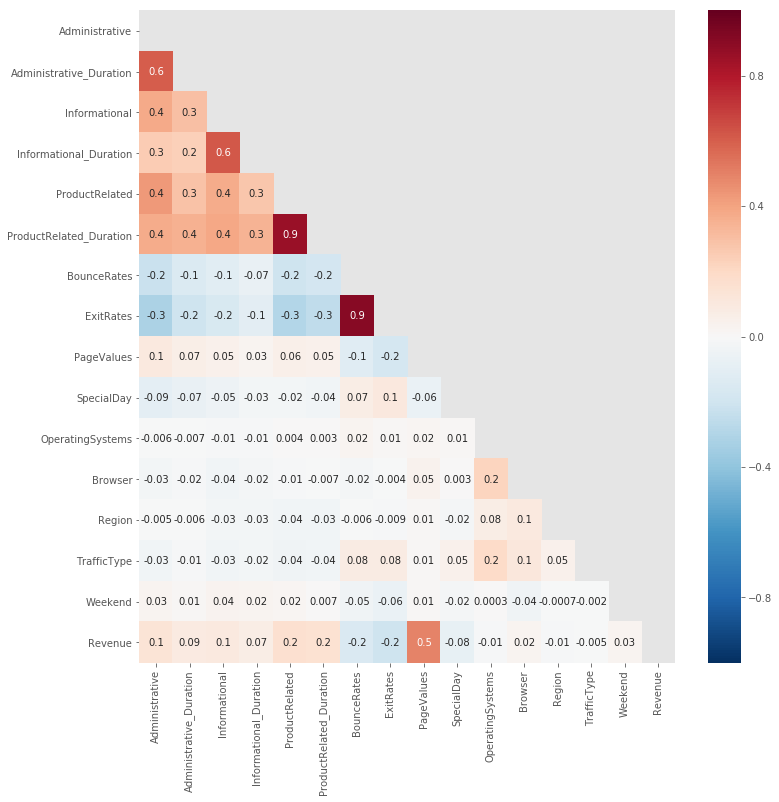
From the above heatmap, we observe the following:
- In general, there is very little correlation among the different features in our dataset.
-
The very few cases of high correlation ( corr >= 0.7) are: - BounceRates & ExitRates (0.9).
- ProductRelated & ProductRelated_Duration (0.9).
-
Moderate Correlations (0.3 < corr < 0.7): - Among the following features: Administrative, Administrative_Duration, Informational, Informational_Duration, ProductRelated, and ProductRelated_Duration.
- Also between PageValues and Revenue.
let’s now show correlation among a few of our features
g1 = sns.pairplot(df[['Administrative', 'Informational', 'ProductRelated', 'PageValues', 'Revenue']], hue='Revenue')
g1.fig.suptitle('Feature Relations')
plt.show()
/Users/manguito/.virtualenvs/myEnv/lib/python3.7/site-packages/scipy/stats/stats.py:1713: FutureWarning: Using a non-tuple sequence for multidimensional indexing is deprecated; use `arr[tuple(seq)]` instead of `arr[seq]`. In the future this will be interpreted as an array index, `arr[np.array(seq)]`, which will result either in an error or a different result.
return np.add.reduce(sorted[indexer] * weights, axis=axis) / sumval
/Users/manguito/.virtualenvs/myEnv/lib/python3.7/site-packages/statsmodels/nonparametric/kde.py:488: RuntimeWarning: invalid value encountered in true_divide
binned = fast_linbin(X, a, b, gridsize) / (delta * nobs)
/Users/manguito/.virtualenvs/myEnv/lib/python3.7/site-packages/statsmodels/nonparametric/kdetools.py:34: RuntimeWarning: invalid value encountered in double_scalars
FAC1 = 2*(np.pi*bw/RANGE)**2
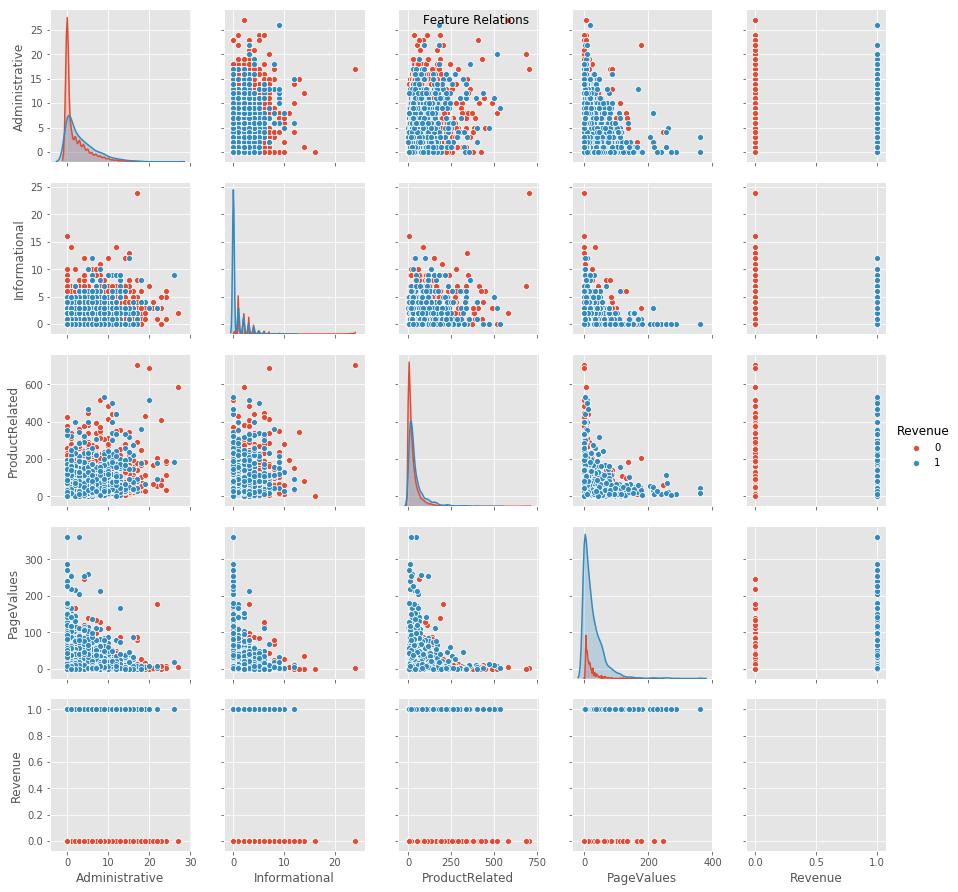
From the above figure, we can see:
- No strong correlation between Revenue (our target) and any other feature.
- A strong negative correlation between PageValues and other features shown.
Web Pages Analysis
fig = plt.figure(figsize=(12, 12))
ax1 = fig.add_subplot(2, 3, 1)
ax2 = fig.add_subplot(2, 3, 2)
ax3 = fig.add_subplot(2, 3, 3)
ax4 = fig.add_subplot(2, 3, 4)
ax5 = fig.add_subplot(2, 3, 5)
ax6 = fig.add_subplot(2, 3, 6)
sns.violinplot(data=df, x = 'Revenue', y = 'Administrative', ax=ax1)
sns.violinplot(data=df, x = 'Revenue', y = 'Informational', ax=ax2)
sns.violinplot(data=df, x = 'Revenue', y = 'ProductRelated', ax=ax3)
sns.boxplot(data=df, x = 'Revenue', y = 'Administrative_Duration', ax=ax4)
sns.boxplot(data=df, x = 'Revenue', y = 'Informational_Duration', ax=ax5)
sns.boxplot(data=df, x = 'Revenue', y = 'ProductRelated_Duration', ax=ax6)
plt.tight_layout()
plt.show()
/Users/manguito/.virtualenvs/myEnv/lib/python3.7/site-packages/scipy/stats/stats.py:1713: FutureWarning: Using a non-tuple sequence for multidimensional indexing is deprecated; use `arr[tuple(seq)]` instead of `arr[seq]`. In the future this will be interpreted as an array index, `arr[np.array(seq)]`, which will result either in an error or a different result.
return np.add.reduce(sorted[indexer] * weights, axis=axis) / sumval
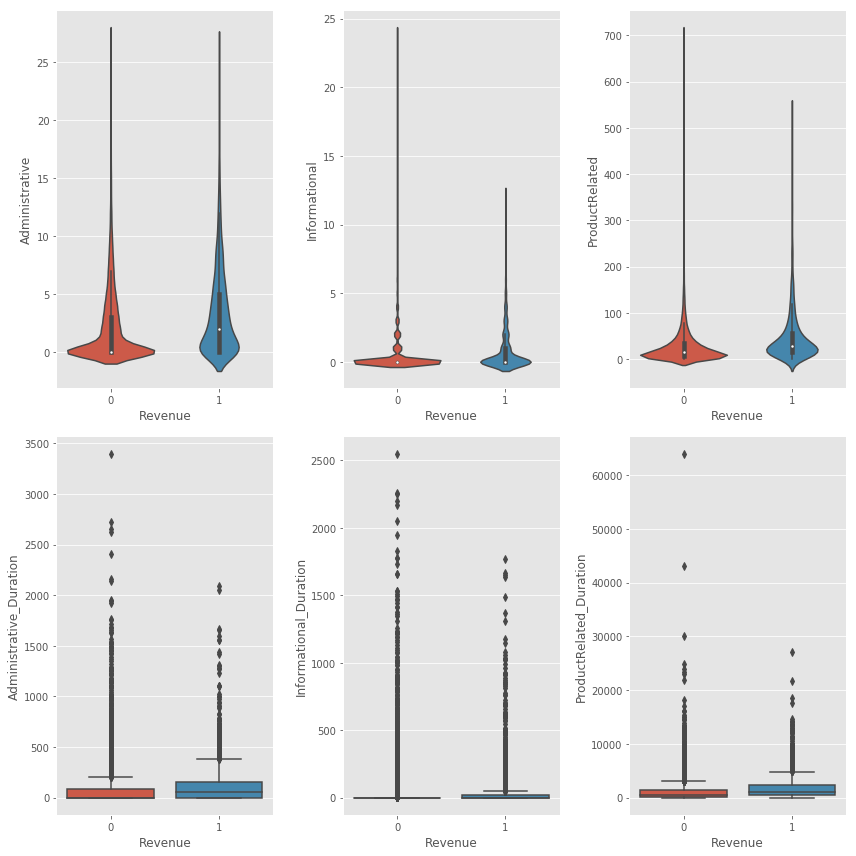
From the above boxplots, we can see that:
- In general, visitors tend to visit less pages, and spend less time, if they are not going to make a purchase.
- The number of product related pages, and the time spent on them, is way higher than that for account related or informational pages.
- The first 3 feature look like they follow a skewed normal distribution.
Page Metrics Analysis
fig = plt.figure(figsize=(16, 4))
ax1 = fig.add_subplot(1, 3, 1)
ax2 = fig.add_subplot(1, 3, 2)
ax3 = fig.add_subplot(1, 3, 3)
sns.distplot(df['BounceRates'], bins=20, ax=ax1)
sns.distplot(df['ExitRates'], bins=20, ax=ax2)
sns.distplot(df['PageValues'], bins=20, ax=ax3)
plt.tight_layout()
plt.show()
/Users/manguito/.virtualenvs/myEnv/lib/python3.7/site-packages/scipy/stats/stats.py:1713: FutureWarning: Using a non-tuple sequence for multidimensional indexing is deprecated; use `arr[tuple(seq)]` instead of `arr[seq]`. In the future this will be interpreted as an array index, `arr[np.array(seq)]`, which will result either in an error or a different result.
return np.add.reduce(sorted[indexer] * weights, axis=axis) / sumval

From the above visualizations of 3 google analytics metrics, we can conclude:
- BounceRates & PageValues do not follow a normal distribution.
- All 3 features have distributions that are skewed right.
- All 3 distributions have a lot of outliers.
- The average bounce and exit rates of most of our data points is low, which is good, since high rates identicate that visitors are not engaging with the website.
- Exit rate has more high values than bounce rate, which makes sense, where transaction confirmation pages for example will cause the average exit rate to increase.
- Bounce rate ==> the percentage where the first page visited was the only page visited in that session.
- Exit rate of a page ==> The percentage where that page was the last page visited in the session, out of all visits to that page.
Visitor Analysis
fig = plt.figure(figsize=(18, 6))
ax1 = fig.add_subplot(2, 2, 1)
ax2 = fig.add_subplot(2, 2, 2)
ax3 = fig.add_subplot(2, 2, 3)
ax4 = fig.add_subplot(2, 2, 4)
sns.countplot(data=df, x='OperatingSystems', hue='VisitorType', ax=ax1)
sns.countplot(data=df, x='Browser', hue='VisitorType', ax=ax2)
sns.countplot(data=df, x='Region', hue='VisitorType', ax=ax3)
sns.countplot(data=df, x='TrafficType', hue='VisitorType', ax=ax4)
ax1.legend(loc='upper right')
ax2.legend(loc='upper right')
ax3.legend(loc='upper right')
ax4.legend(loc='upper right')
plt.tight_layout()
plt.show()

- 1 Operating system is responsible for ~7000 of the examples in our dataset.
- 4 of the 8 operating systems used, are responsible of a very small number (<200) of the examples in our dataset.
- A similar story repeated with the browsers used by visitors, where there is 1 dominant browser, 3 with decent representation in the dataset, and the rest are rarey used.
- It looks like we have a very regionally diverse traffic in our dataset.
- Also Traffic sources are very diverse, with a few that did not contribute much to the dataset.
Visit Date Analysis
fig = plt.figure(figsize=(18, 12))
ax1 = fig.add_subplot(2, 1, 1)
ax2 = fig.add_subplot(2, 1, 2)
orderlist = ['Jan','Feb','Mar','Apr','May','June','Jul','Aug','Sep','Oct','Nov','Dec']
sns.countplot(data=df, x='Month', hue='Revenue', ax=ax1, order=orderlist)
sns.countplot(data=df, x='SpecialDay', hue='Revenue', ax=ax2)
plt.tight_layout()
plt.show()
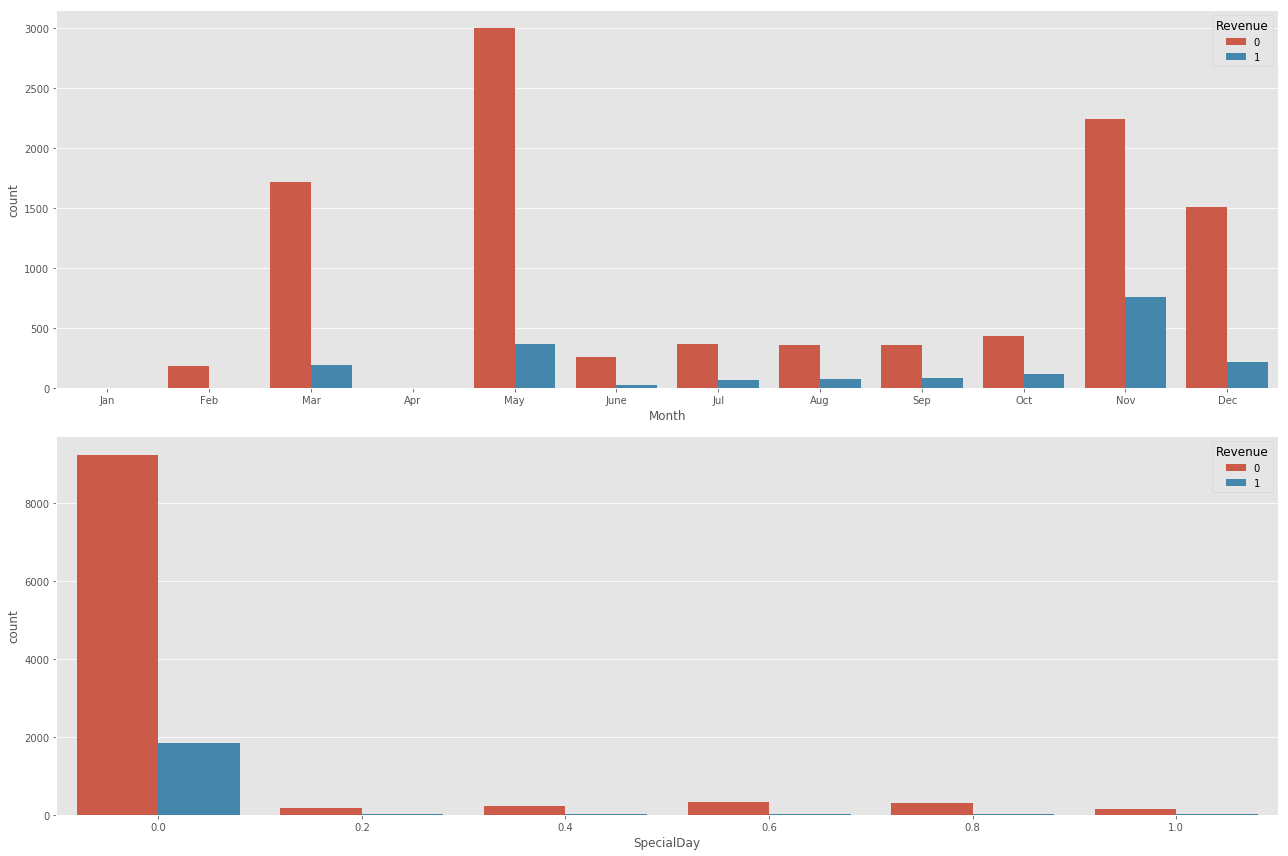
fig, ax = plt.subplots(1, 2,figsize=(12, 6), subplot_kw=dict(aspect="equal"))
ax[0].pie(df['Weekend'].value_counts(),explode=(0.1,0),labels=['Weekday','Weekend'], autopct='%1.0f%%')
ax[0].set_title('Weekend vs. Weekday (Total Visits)')
ax[1].pie(df[df['Revenue'] == 1]['Weekend'].value_counts(),explode=(0.1,0),labels=['Weekday','Weekend'], autopct='%1.0f%%')
ax[1].set_title('Weekend vs. Weekday (Only Visits Ended with Transactions)')
#fig.suptitle('Weekend Visits')
plt.show()
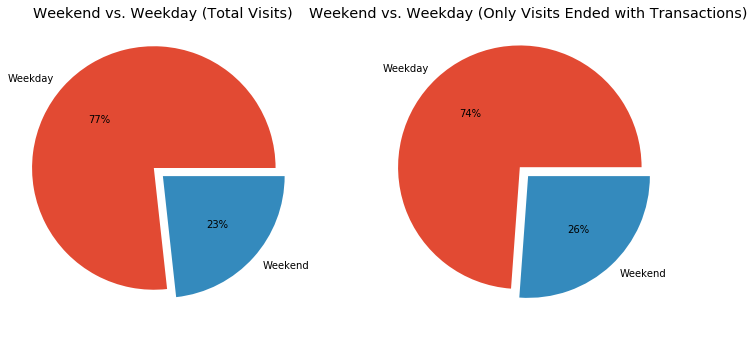
- On March and May, we have a lot of visits (May is the month with the highest number of visits), yet transactions made during those 2 months are not on the same level.
- We have no visits at all during Jan nor Apr.
- Most transactions happen during the end of the year, with Nov as the month with the highest number of confirmed transactions.
- The closer the visit date to a special day (like black Friday, new year’s, … etc) the more likely it will end up in a transaction.
- Most of transactions happen on special days (SpecialDay =0).
- It does not look like weekends affect the number of visits or transactions much, we can see only a slight increase in the number of transactions happening on weekends compared to those on weekdays.
Data Pre-Processing
In this section we will make our data ready for model training. This will include:
- Transform Month and VisitorType columns into numerical (binary) values.
- Split data set into training, validation, and testing parts (70/15/15), while separating Revenue column, where it will be used as our labels.
- We will ably feature scaling on our input data, in order to be used for Naive Bayes and SVM model training.
Data Transformation
dff = pd.concat([df,pd.get_dummies(df['Month'], prefix='Month')], axis=1).drop(['Month'],axis=1)
dff = pd.concat([dff,pd.get_dummies(dff['VisitorType'], prefix='VisitorType')], axis=1).drop(['VisitorType'],axis=1)
print(dff.info())
<class 'pandas.core.frame.DataFrame'>
RangeIndex: 12330 entries, 0 to 12329
Data columns (total 29 columns):
# Column Non-Null Count Dtype
--- ------ -------------- -----
0 Administrative 12330 non-null int64
1 Administrative_Duration 12330 non-null float64
2 Informational 12330 non-null int64
3 Informational_Duration 12330 non-null float64
4 ProductRelated 12330 non-null int64
5 ProductRelated_Duration 12330 non-null float64
6 BounceRates 12330 non-null float64
7 ExitRates 12330 non-null float64
8 PageValues 12330 non-null float64
9 SpecialDay 12330 non-null float64
10 OperatingSystems 12330 non-null int64
11 Browser 12330 non-null int64
12 Region 12330 non-null int64
13 TrafficType 12330 non-null int64
14 Weekend 12330 non-null int64
15 Revenue 12330 non-null int64
16 Month_Aug 12330 non-null uint8
17 Month_Dec 12330 non-null uint8
18 Month_Feb 12330 non-null uint8
19 Month_Jul 12330 non-null uint8
20 Month_June 12330 non-null uint8
21 Month_Mar 12330 non-null uint8
22 Month_May 12330 non-null uint8
23 Month_Nov 12330 non-null uint8
24 Month_Oct 12330 non-null uint8
25 Month_Sep 12330 non-null uint8
26 VisitorType_New_Visitor 12330 non-null uint8
27 VisitorType_Other 12330 non-null uint8
28 VisitorType_Returning_Visitor 12330 non-null uint8
dtypes: float64(7), int64(9), uint8(13)
memory usage: 1.7 MB
None
dff.head()
| Administrative | Administrative_Duration | Informational | Informational_Duration | ProductRelated | ProductRelated_Duration | BounceRates | ExitRates | PageValues | SpecialDay | ... | Month_Jul | Month_June | Month_Mar | Month_May | Month_Nov | Month_Oct | Month_Sep | VisitorType_New_Visitor | VisitorType_Other | VisitorType_Returning_Visitor | |
|---|---|---|---|---|---|---|---|---|---|---|---|---|---|---|---|---|---|---|---|---|---|
| 0 | 0 | 0.0 | 0 | 0.0 | 1 | 0.000000 | 0.20 | 0.20 | 0.0 | 0.0 | ... | 0 | 0 | 0 | 0 | 0 | 0 | 0 | 0 | 0 | 1 |
| 1 | 0 | 0.0 | 0 | 0.0 | 2 | 64.000000 | 0.00 | 0.10 | 0.0 | 0.0 | ... | 0 | 0 | 0 | 0 | 0 | 0 | 0 | 0 | 0 | 1 |
| 2 | 0 | 0.0 | 0 | 0.0 | 1 | 0.000000 | 0.20 | 0.20 | 0.0 | 0.0 | ... | 0 | 0 | 0 | 0 | 0 | 0 | 0 | 0 | 0 | 1 |
| 3 | 0 | 0.0 | 0 | 0.0 | 2 | 2.666667 | 0.05 | 0.14 | 0.0 | 0.0 | ... | 0 | 0 | 0 | 0 | 0 | 0 | 0 | 0 | 0 | 1 |
| 4 | 0 | 0.0 | 0 | 0.0 | 10 | 627.500000 | 0.02 | 0.05 | 0.0 | 0.0 | ... | 0 | 0 | 0 | 0 | 0 | 0 | 0 | 0 | 0 | 1 |
5 rows × 29 columns
Data Split
y = dff['Revenue']
X = dff.drop(['Revenue'], axis=1)
len(y)
12330
X_train, X_valtest, y_train, y_valtest = train_test_split(X, y, test_size=0.3, random_state=101)
X_val, X_test, y_val, y_test = train_test_split(X_valtest, y_valtest, test_size=0.5, random_state=101)
Now we have the following data subsets:
- Train data (X_train) and trin labels (y_train) ==> 70%
- Validation data (X_val) and validation labels (y_val) ==> 15%
- Test data (X_test) and test labels (y)test) ==> 15%
Data Scaling
We will scale the features in our subsets, in order to use them to train, validate, and test models that will benefit from feature scaling.
sc_X = StandardScaler()
Xsc_train = sc_X.fit_transform(X_train)
Xsc_val = sc_X.fit_transform(X_val)
Xsc_test = sc_X.fit_transform(X_test)
/Users/manguito/.virtualenvs/myEnv/lib/python3.7/site-packages/sklearn/preprocessing/data.py:645: DataConversionWarning: Data with input dtype uint8, int64, float64 were all converted to float64 by StandardScaler.
return self.partial_fit(X, y)
/Users/manguito/.virtualenvs/myEnv/lib/python3.7/site-packages/sklearn/base.py:464: DataConversionWarning: Data with input dtype uint8, int64, float64 were all converted to float64 by StandardScaler.
return self.fit(X, **fit_params).transform(X)
/Users/manguito/.virtualenvs/myEnv/lib/python3.7/site-packages/sklearn/preprocessing/data.py:645: DataConversionWarning: Data with input dtype uint8, int64, float64 were all converted to float64 by StandardScaler.
return self.partial_fit(X, y)
/Users/manguito/.virtualenvs/myEnv/lib/python3.7/site-packages/sklearn/base.py:464: DataConversionWarning: Data with input dtype uint8, int64, float64 were all converted to float64 by StandardScaler.
return self.fit(X, **fit_params).transform(X)
/Users/manguito/.virtualenvs/myEnv/lib/python3.7/site-packages/sklearn/preprocessing/data.py:645: DataConversionWarning: Data with input dtype uint8, int64, float64 were all converted to float64 by StandardScaler.
return self.partial_fit(X, y)
/Users/manguito/.virtualenvs/myEnv/lib/python3.7/site-packages/sklearn/base.py:464: DataConversionWarning: Data with input dtype uint8, int64, float64 were all converted to float64 by StandardScaler.
return self.fit(X, **fit_params).transform(X)
Model Building
Logistic Regression
lrm = LogisticRegression(C=1.0,solver='lbfgs',max_iter=10000) #default parameters
lrm.fit(X_train,y_train)
lrm_pred = lrm.predict(X_val)
print('Logistic Regression initial Performance:')
print('----------------------------------------')
print('Accuracy : ', metrics.accuracy_score(y_val, lrm_pred))
print('F1 Score : ', metrics.f1_score(y_val, lrm_pred))
print('Precision : ', metrics.precision_score(y_val, lrm_pred))
print('Recall : ', metrics.recall_score(y_val, lrm_pred))
print('Confusion Matrix:\n ', confusion_matrix(y_val, lrm_pred))
Logistic Regression initial Performance:
----------------------------------------
Accuracy : 0.8783126014061655
F1 Score : 0.5243128964059196
Precision : 0.7515151515151515
Recall : 0.4025974025974026
Confusion Matrix:
[[1500 41]
[ 184 124]]
K-fold Cross-Validation
https://scikit-learn.org/stable/auto_examples/model_selection/plot_cv_indices.html#sphx-glr-auto-examples-model-selection-plot-cv-indices-py
from sklearn.model_selection import (TimeSeriesSplit, KFold, ShuffleSplit,
StratifiedKFold, GroupShuffleSplit,
GroupKFold, StratifiedShuffleSplit)
from matplotlib.patches import Patch
np.random.seed(1338)
cmap_data = plt.cm.Paired
cmap_cv = plt.cm.coolwarm
n_splits = 4
Split data into train and test data
X_train, X_test, y_train, y_test = train_test_split(X, y, test_size=0.3, random_state=101)
Xsc_train = sc_X.fit_transform(X_train)
Xsc_test = sc_X.fit_transform(X_test)
Xsc_train_df = pd.DataFrame(Xsc_train, index=X_train.index, columns=X_train.columns)
Xsc_test_df = pd.DataFrame(Xsc_test, index=X_test.index, columns=X_test.columns)
/Users/manguito/.virtualenvs/myEnv/lib/python3.7/site-packages/sklearn/preprocessing/data.py:645: DataConversionWarning: Data with input dtype uint8, int64, float64 were all converted to float64 by StandardScaler.
return self.partial_fit(X, y)
/Users/manguito/.virtualenvs/myEnv/lib/python3.7/site-packages/sklearn/base.py:464: DataConversionWarning: Data with input dtype uint8, int64, float64 were all converted to float64 by StandardScaler.
return self.fit(X, **fit_params).transform(X)
/Users/manguito/.virtualenvs/myEnv/lib/python3.7/site-packages/sklearn/preprocessing/data.py:645: DataConversionWarning: Data with input dtype uint8, int64, float64 were all converted to float64 by StandardScaler.
return self.partial_fit(X, y)
/Users/manguito/.virtualenvs/myEnv/lib/python3.7/site-packages/sklearn/base.py:464: DataConversionWarning: Data with input dtype uint8, int64, float64 were all converted to float64 by StandardScaler.
return self.fit(X, **fit_params).transform(X)
X_train.head()
| Administrative | Administrative_Duration | Informational | Informational_Duration | ProductRelated | ProductRelated_Duration | BounceRates | ExitRates | PageValues | SpecialDay | ... | Month_Jul | Month_June | Month_Mar | Month_May | Month_Nov | Month_Oct | Month_Sep | VisitorType_New_Visitor | VisitorType_Other | VisitorType_Returning_Visitor | |
|---|---|---|---|---|---|---|---|---|---|---|---|---|---|---|---|---|---|---|---|---|---|
| 7821 | 6 | 105.633333 | 2 | 105.95 | 8 | 246.386508 | 0.000000 | 0.008929 | 0.000000 | 0.0 | ... | 0 | 0 | 0 | 0 | 1 | 0 | 0 | 0 | 0 | 1 |
| 6701 | 0 | 0.000000 | 0 | 0.00 | 14 | 317.066667 | 0.035714 | 0.050000 | 0.000000 | 0.0 | ... | 0 | 0 | 0 | 0 | 0 | 0 | 0 | 0 | 0 | 1 |
| 11312 | 1 | 21.250000 | 0 | 0.00 | 92 | 2716.519048 | 0.006738 | 0.037885 | 23.738911 | 0.0 | ... | 0 | 0 | 0 | 0 | 1 | 0 | 0 | 0 | 0 | 1 |
| 3873 | 0 | 0.000000 | 0 | 0.00 | 7 | 203.666667 | 0.000000 | 0.009524 | 0.000000 | 0.0 | ... | 0 | 0 | 0 | 1 | 0 | 0 | 0 | 0 | 0 | 1 |
| 9319 | 1 | 14.000000 | 0 | 0.00 | 50 | 1317.795833 | 0.010000 | 0.021470 | 0.000000 | 0.0 | ... | 0 | 0 | 0 | 0 | 1 | 0 | 0 | 0 | 0 | 1 |
5 rows × 28 columns
Xsc_train_df.head()
| Administrative | Administrative_Duration | Informational | Informational_Duration | ProductRelated | ProductRelated_Duration | BounceRates | ExitRates | PageValues | SpecialDay | ... | Month_Jul | Month_June | Month_Mar | Month_May | Month_Nov | Month_Oct | Month_Sep | VisitorType_New_Visitor | VisitorType_Other | VisitorType_Returning_Visitor | |
|---|---|---|---|---|---|---|---|---|---|---|---|---|---|---|---|---|---|---|---|---|---|
| 7821 | 1.131955 | 0.156268 | 1.186984 | 0.530696 | -0.536100 | -0.517481 | -0.458955 | -0.704386 | -0.309198 | -0.307883 | ... | -0.192693 | -0.152435 | -0.426241 | -0.614893 | 1.762410 | -0.213717 | -0.197492 | -0.396978 | -0.078604 | 0.407282 |
| 6701 | -0.696588 | -0.460087 | -0.392550 | -0.246800 | -0.398929 | -0.478028 | 0.279525 | 0.142770 | -0.309198 | -0.307883 | ... | -0.192693 | -0.152435 | -0.426241 | -0.614893 | -0.567405 | -0.213717 | -0.197492 | -0.396978 | -0.078604 | 0.407282 |
| 11312 | -0.391831 | -0.336096 | -0.392550 | -0.246800 | 1.384297 | 0.861314 | -0.319639 | -0.107113 | 0.951488 | -0.307883 | ... | -0.192693 | -0.152435 | -0.426241 | -0.614893 | 1.762410 | -0.213717 | -0.197492 | -0.396978 | -0.078604 | 0.407282 |
| 3873 | -0.696588 | -0.460087 | -0.392550 | -0.246800 | -0.558962 | -0.541327 | -0.458955 | -0.692108 | -0.309198 | -0.307883 | ... | -0.192693 | -0.152435 | -0.426241 | 1.626299 | -0.567405 | -0.213717 | -0.197492 | -0.396978 | -0.078604 | 0.407282 |
| 9319 | -0.391831 | -0.378399 | -0.392550 | -0.246800 | 0.424098 | 0.080565 | -0.252181 | -0.445712 | -0.309198 | -0.307883 | ... | -0.192693 | -0.152435 | -0.426241 | -0.614893 | 1.762410 | -0.213717 | -0.197492 | -0.396978 | -0.078604 | 0.407282 |
5 rows × 28 columns
n_splits = 5
fig, ax = plt.subplots(figsize = (10,8))
cv = KFold(n_splits)
for ii, (tr, tt) in enumerate(cv.split(X=X_train, y=y_train)):
# Fill in indices with the training/test groups
indices = np.array([np.nan] * len(X))
indices[tt] = 1
indices[tr] = 0
ax.scatter(range(len(indices)), [ii ] * len(indices),
c=indices, marker='_', lw=10, cmap=cmap_cv,
vmin=-.2, vmax=1.2)
yticklabels = [i+1 for i in list(range(n_splits))]
ax.set(yticks=np.arange(n_splits), yticklabels=yticklabels,
xlabel='Sample index', ylabel="CV iteration",
ylim=[n_splits, -.2], xlim=[0, len(y)])
ax.set_title('{}'.format(type(cv).__name__), fontsize=15)
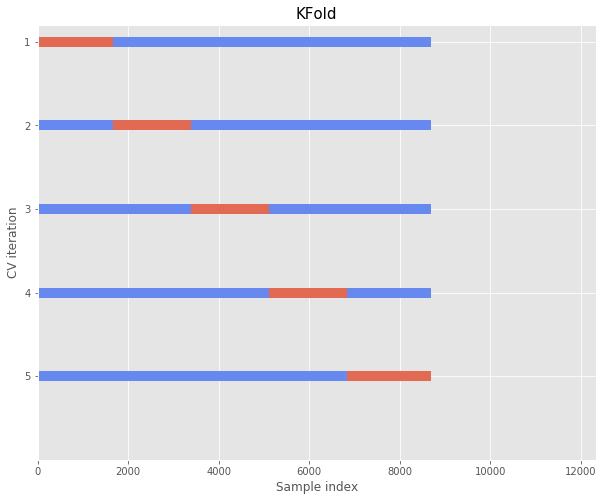
Compare accuracy of logistic regression and KNN
Note that we need to use scaled variables for KNN
logStats = {}
knnStats = {}
for ii, (tr, tt) in enumerate(cv.split(X=X_train, y=y_train)):
# Fill in indices with the training/test groups
indices = np.array([np.nan] * len(X))
indices[tt] = 1
indices[tr] = 0
# train Logistic Regression Model
lrm = LogisticRegression(C=1.0,solver='lbfgs',max_iter=10000) #default parameters
lrm.fit(X_train.iloc[tr,:],y_train.iloc[tr])
lrm_pred = lrm.predict(X_train.iloc[tt,:])
y_val = y_train.iloc[tt]
print('Logistic Regression initial Performance:')
print('----------------------------------------')
print('Accuracy : ', metrics.accuracy_score(y_val, lrm_pred))
print('F1 Score : ', metrics.f1_score(y_val, lrm_pred))
print('Precision : ', metrics.precision_score(y_val, lrm_pred))
print('Recall : ', metrics.recall_score(y_val, lrm_pred))
print('Confusion Matrix:\n ', confusion_matrix(y_val, lrm_pred))
logStats.setdefault('accuracy', []).append(metrics.accuracy_score(y_val, lrm_pred))
knn = KNeighborsClassifier(n_neighbors=5,weights='uniform',leaf_size=30,p=2) #default values
knn.fit(Xsc_train_df.iloc[tr,:],y_train.iloc[tr])
knn_pred = knn.predict(Xsc_train_df.iloc[tt,:])
print('K-Nearest Neighbor Initial Performance:')
print('---------------------------------------')
print('Accuracy : ', metrics.accuracy_score(y_val, knn_pred))
print('F1 Score : ', metrics.f1_score(y_val, knn_pred))
print('Precision : ', metrics.precision_score(y_val, knn_pred))
print('Recall : ', metrics.recall_score(y_val, knn_pred))
print('Confusion Matrix:\n ', confusion_matrix(y_val, knn_pred))
knnStats.setdefault('accuracy', []).append(metrics.accuracy_score(y_val, knn_pred))
Logistic Regression initial Performance:
----------------------------------------
Accuracy : 0.8726114649681529
F1 Score : 0.45544554455445546
Precision : 0.773109243697479
Recall : 0.32280701754385965
Confusion Matrix:
[[1415 27]
[ 193 92]]
K-Nearest Neighbor Initial Performance:
---------------------------------------
Accuracy : 0.8581354950781702
F1 Score : 0.40389294403892945
Precision : 0.6587301587301587
Recall : 0.2912280701754386
Confusion Matrix:
[[1399 43]
[ 202 83]]
Logistic Regression initial Performance:
----------------------------------------
Accuracy : 0.8823870220162224
F1 Score : 0.5012285012285012
Precision : 0.7338129496402878
Recall : 0.3805970149253731
Confusion Matrix:
[[1421 37]
[ 166 102]]
K-Nearest Neighbor Initial Performance:
---------------------------------------
Accuracy : 0.8742757821552724
F1 Score : 0.4668304668304668
Precision : 0.6834532374100719
Recall : 0.35447761194029853
Confusion Matrix:
[[1414 44]
[ 173 95]]
Logistic Regression initial Performance:
----------------------------------------
Accuracy : 0.8818076477404403
F1 Score : 0.5
Precision : 0.7445255474452555
Recall : 0.3763837638376384
Confusion Matrix:
[[1420 35]
[ 169 102]]
K-Nearest Neighbor Initial Performance:
---------------------------------------
Accuracy : 0.8719582850521437
F1 Score : 0.45161290322580644
Precision : 0.6893939393939394
Recall : 0.33579335793357934
Confusion Matrix:
[[1414 41]
[ 180 91]]
Logistic Regression initial Performance:
----------------------------------------
Accuracy : 0.8939745075318656
F1 Score : 0.5040650406504066
Precision : 0.7322834645669292
Recall : 0.384297520661157
Confusion Matrix:
[[1450 34]
[ 149 93]]
K-Nearest Neighbor Initial Performance:
---------------------------------------
Accuracy : 0.8765932792584009
F1 Score : 0.4132231404958678
Precision : 0.6198347107438017
Recall : 0.30991735537190085
Confusion Matrix:
[[1438 46]
[ 167 75]]
Logistic Regression initial Performance:
----------------------------------------
Accuracy : 0.8783314020857474
F1 Score : 0.5047169811320754
Precision : 0.7039473684210527
Recall : 0.39338235294117646
Confusion Matrix:
[[1409 45]
[ 165 107]]
K-Nearest Neighbor Initial Performance:
---------------------------------------
Accuracy : 0.8725376593279258
F1 Score : 0.4634146341463415
Precision : 0.6884057971014492
Recall : 0.3492647058823529
Confusion Matrix:
[[1411 43]
[ 177 95]]
np.mean(logStats['accuracy']),np.mean(knnStats['accuracy'])
(0.8818224088684857, 0.8707001001743826)
